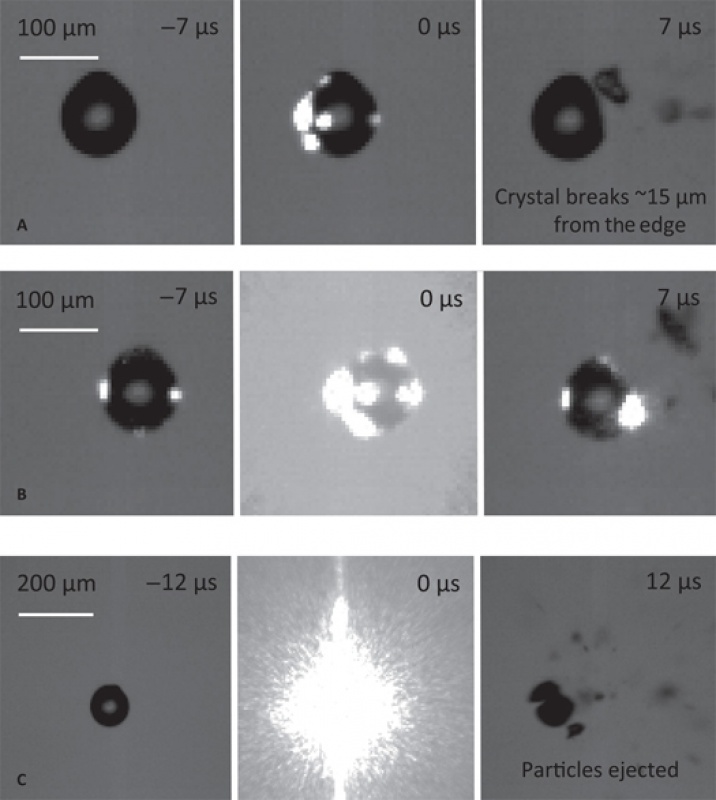Zapping clouds with lasers could tweak planet’s temperature
May 20, 2016Future technology might allow manipulation of ice crystals to alter climate
| Mary Matthews, Jean-Pierre Wolf and co-workers investigate the interaction of ultrashort laser filaments with individual 90-μm ice particles, representative of cirrus particles. The ice particles fragment under laser illumination. By monitoring the evolution of the corresponding ice/vapor system at up to 140,000 frames per second over 30 ms, we conclude that a shockwave vaporization supersaturates the neighboring region relative to ice, allowing the nucleation and growth of new ice particles, supported by laser-induced plasma photochemistry. This process constitutes the first direct observation of filament-induced secondary ice multiplication, a process that strongly modifies the particle size distribution and, thus, the albedo of typical cirrus clouds. | ||
 | ||
The researchers injected water drops into a chilled chamber that mimics the frigid conditions high in the atmosphere, where wispy cirrus clouds live. The water froze into spherical ice particles, which the scientists walloped with short, intense bursts of laser light.When the laser hits an ice particle, ultrahot plasma forms at its center, producing a shock wave that breaks the particle apart and vaporizes much of the ice. The excess water vapor left in the aftermath then condenses and freezes into new, smaller ice particles. Applying this technique to clouds is “a long, long, long way in the future,” says physicist Mary Matthews of the University of Geneva, a coauthor of the study. Current laser technology is not up to the task of cloud zapping — yet. “What we are hoping for is that the advances in laser technology, which are moving faster and faster all the time, will enable high-powered, mobile lasers,” Matthews says. Reference: Matthews, M., F. Pomel, C. Wender, A. Kiselev, D. Duft, J. Kasparian, J.-P. Wolf and T. Leisner (2016). Laser vaporization of cirrus-like ice particles with secondary ice multiplication. Sci. Adv. 2. (10.1126/sciadv.1501912)  Matthews-2016 (896 KB). Matthews-2016 (896 KB). |

 Ursula Keller wins “Swiss Nobel” Marcel Benoist Prize
Ursula Keller wins “Swiss Nobel” Marcel Benoist Prize Farewell: the NCCR MUST ended
Farewell: the NCCR MUST ended  MUST2022 Conference
MUST2022 Conference New scientific highlights
New scientific highlights FELs of Europe prize for Jeremy Rouxel
FELs of Europe prize for Jeremy Rouxel Ruth Signorell wins Doron prize
Ruth Signorell wins Doron prize New FAST-Fellow Uwe Thumm at ETH
New FAST-Fellow Uwe Thumm at ETH International Day of Women and Girls in Science
International Day of Women and Girls in Science New scientific highlight
New scientific highlight EU XFEL Young Scientist Award for Camila Bacellar,
EU XFEL Young Scientist Award for Camila Bacellar, Prizes for Giulia Mancini and Rebeca Gomez Castillo
Prizes for Giulia Mancini and Rebeca Gomez Castillo Nobel Prize in Chemistry awarded to RESOLV Member Benjamin List
Nobel Prize in Chemistry awarded to RESOLV Member Benjamin List Hans Jakob Wörner invited to give the „New Horizons Solvay Lectures”
Hans Jakob Wörner invited to give the „New Horizons Solvay Lectures”  Unusual keynote talk at an international scientific conference
Unusual keynote talk at an international scientific conference NCCR MUST at Scientifica 2021
NCCR MUST at Scientifica 2021